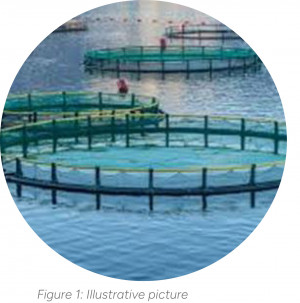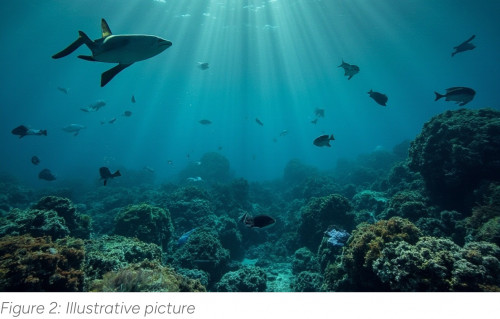Monitoring of Aquatic Ecosystems
Published: March 2025
Download PDF
EnviroMail_25_Europe_Monitoring of Aquatic Ecosystems

The Aquaculture Stewardship Council (ASC) is an independent, nonprofit organization that sets global standards to ensure responsible and sustainable aquaculture that respects aquatic ecosystems. ASCstandards focus on minimizing environmental impacts, including those on benthic, bottomsthrough the use of abiotic indicators (such as free sulfides and redox potential) and biotic indicators (such as benthic species diversity and abundance of faunal communities).
EBI Index
The Extended Biotic Index (EBI) is a widely used scientific method for assessing the biological quality of water bodies through the study of benthic macroinvertebrate communities. This index is based on the presence, abundance, and sensitivity of specific organisms (such as aquatic
nsects, mollusks, crustaceans, and annelids)
to changes in environmental conditions.
EBI is particularly effective in:
- Identifying ecological alterations caused by organic and chemical pollution.
- Assessing benthic biodiversity and ecosystem resilience.
- Determining the degree of anthropogenic impact on aquatic habitats.
The EBI is distinguished by its ability to provide direct data on the ecological status of waterways by integrating information from chemical and physical indicators.
The ASC standards require the assessment of aquaculture impacts using a combination of abiotic and biotic metrics. However, these indicators alone are insufficient to fully capture the complexities of ecological dynamics.
EBI plays a key role as a tool for:
- Validating and supporting the data collected through the chemical and physical parameters required by ASC standards.
- Providing a clear view of biological status, identifying key species and indicators of degradation.
- Improving the accuracy of ecological status assessments by providing a more detailed understanding of environmental conditions.
ASC does not prescribe specific methodologies for assessing environmental impacts but offers flexibility in adopting scientifically validated tools.
The EBI, with its approach based on macrobenthic community composition, can complement the monitoring programs required by ASC standards, particularly in contexts where benthic impacts are difficult to detect using chemical and physical metrics alone.
In conclusion, the ASC, as an independent nonprofit organization, provides the global regulatory framework and threshold values for relevant certification, utilizing the IBE as a practical and scientific tool to accurately monitor ecosystem health, thereby ensuring the sustainable management of aquaculture activities.
In General
Ecological status is evaluated primarily based on the composition and abundance of the following elements:
- Biological quality elements (BQE)
- Trophic status (LIMeco for rivers and LTLeco for lakes)
- Hydromorphological conditions that characterize the aquatic ecosystem
Contributing to the definition of "ecological status" are:
- Biological elements
- Hydromorphological elements supporting biological conditions
- Chemical and physicochemical elements supporting biological conditions
- Specific pollutants
In defining ecological status, the assessment of biological elements is therefore predominant, while the other types of elements are considered to provide a broader and clearer understanding of the status of biological communities within the aquatic ecosystem under consideration.
ALS Analyses
We perform ecological analyses on waterways impacted by disturbances caused by anthropogenic activities (e.g., discharges from aquaculture facilities, sewage treatment plants, paper mills, and hydroelectric power plants). These analyses focus on ecological quality elements, including benthic macroinvertebrates, macrophytes, and diatoms.
Macroinvertebrates
The classification system applied is called MacrOper, which is based on the calculation of the STAR Multimetric Intercalibration Index (STAR_ICMi) and the proportional multihabitat sampling procedure.
The STAR_ICMi is a multi-metric index based on a set of indicators (sub-indices) that provide information on tolerance, abundance/habitat, and richness/diversity regarding the community. Index calculations should be conducted on a type-specific basis.
Benthic Diatoms
The ICMi ("Multimetric Intercalibration Index") is applied, which assesses species and their sensitivity to pollutants.
The ICMi is composed of two indices:
- Pollutant Sensitivity Index" (IPS)
- "Trophic Index" (TI)
The result is translated into a scale of five quality classes, ranging from bad to high status.
Macrophytes
The IBMR ("Index Biologique Macrophyitique en Rivière") is applied. This index is designed to assess trophic status (understood in terms of primary production intensity) and is based on the use of a list of indicator taxa, each associated with an indicator value reflecting sensitivity to high levels of trophic conditions.

Accredited Analyses
- Microscopic analysis and macroinvertebrate taxonomic determination: IBE Method: APAT CNR IRSA 9010 Manual 29 2003.
- Microscopic analysis and taxonomic identification of macroinvertebrates: STAR Multimetric Intercalibration Index (STAR_ICMi), ISPRA Manuals and Guidelines 107/2014 and ISPRA Manuals and Guidelines 111/2014.
- Microscopic analysis and taxonomic determination of diatoms - ICMi ISTISAN Reports 09/19 and ISPRA Manuals and Guidelines 111/2014.
- Level Pollution Macrodescriptors (LIMeco) ISO 15923-1 2013; UNI 11757:2019; UNI EN ISO 5814:2013; and DM 08/11/2010 SO n 31 OJ n 30 07/02/2011.
Other and Non-Accredited Analyses
- Microscopic analysis and taxonomic determination Macrophytes - IBMR NF T 90- 395 (AFNOR 2003) and ISPRA, Manuals and Guidelines 111/2014.


